Care Coordination is the act of empowering cross-community collaboration and communication to deliver effective treatment and care, a task that is almost impossible without the right people and technology.
Healthcare costs are spiralling upwards, with an ageing population and a growing number of people with multiple chronic illnesses. Healthcare organisations are having to provide care for a larger number of patients that require more intense and costly interventions. One of the reasons costs are increasing for healthcare organisations, is the high hospital readmission rates.
Well-coordinated care can save health systems astronomical amounts of money by allowing all clinicians in a circle of care to act as one team, reducing avoidable hospital visits and unnecessary treatment orders. More importantly, it has the ability to improve the quality and delivery of care to optimise health outcomes.
The Burgundy region in France was grappling with an ageing population. They needed a solution dedicated to coordinated care to try and keep their population well in their own homes and out of the hospitals. It was necessary to be compulsory and accessible by all professionals involved in a patient’s care. The resulting solution gives the patient visibility of their care plan and aligned care choices they could make to benefit their health to stay in their own home.
The French Ministry of Health is funding a nationwide program called eTICSS (Territoire Innovant Coordonné Santé Social, or Innovative Social Care Coordination). Orion Health partnered with CSC – initially focused on the North of the Saône et Loire area in Burgundy, representing a population of 350,000. The objective was to build trust and collaboration among healthcare and social care professionals in both public and private sectors in this region.
An online patient portal was created that is accessed from computers and mobile devices, to allow a patient and their extended family, no matter where they live. Patients and their care team use the available tools for basic tasks – reviewing goals, medications, results, education materials, and checking appointment times. The solution has technology-enabled collaboration services for healthcare professionals, meaning they can easily coordinate the delivery of planned care to provide the patient with the right care, in the right place, at the right time.
Monique, a 77 year old patient who lives in the village of Toulon-sur-Arroux, has 10 caregivers in her care team, including her General Practitioner (GP), home care nurses and home help, to assist with meals and housework. The eTICSS solution has allowed all the professionals in her care team to view her personalised care plan and ensure her home care is delivered in a coordinated (standard) manner. Monique has been a patient since 2005, but she has recently developed a cognitive disorder. The care team was able to coordinate and arrange for her to go to a day clinic once a week, which had noticeable health improvement results. Care coordinators said Monique was more interactive, meeting and talking to others, and they saw a positive change in her behaviour.
Monique’s story is an example of how a coordinated health system can improve patient outcomes and save hospitals money through coordinated care teams. Burgundy’s eTICSS solution ensures the patient is placed at the ‘centre of care’ within a population health solution, consisting of a platform that aggregates, stores and analyses data, as well as applications that surface data in real-time to health professionals, patients and members of their circle of care, including family members who may live outside the region.
To achieve a healthier population, it requires a health solution and delivery model that knows and connects with people every time they engage with a healthcare provider, not just when they are sick or disadvantaged. Coordinated care has the potential to radically improve quality, patient safety and to reduce costs at a time when this is of vital importance in all areas of healthcare delivery.
To learn more about Monique’s story, watch the video below.



